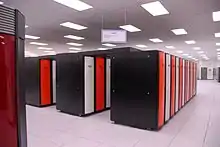Catamount (operating system)
Catamount is an operating system for supercomputers.[1]

Catamount is a lightweight kernel that provides basic functionality and aims for efficiency. The roots of Catamount go back to 1991 when SUNMOS was developed by Sandia National Laboratories and the University of New Mexico as a lightweight operating system. The Cray XT3 uses Catamount on compute nodes and Linux on server nodes.[1]
A case study by the IEEE assessed the performance of a particle transport code on AWE's Cray XT3 8,000-core supercomputer while running images of the Catamount and the Cray Linux Environment (CLE) operating systems. This work demonstrated that by running a number of small benchmarks on a test machine it is possible to speculate as to the performance impact of upgrading from one operating system to another on the system as a whole. The study's findings allows researchers to minimise system downtime while exploring software-system upgrades. The results show that benchmark tests run on less than 256 cores would suggest that the impact of upgrading the operating system to CLE was less than 10%.[2]
See also
References
- An Evaluation of the Oak Ridge National Laboratory Cray XT3 by Sadaf R. Alam etal International Journal of High Performance Computing Applications February 2008 vol. 22 no. 1 52-80
- Hammond, S.D.; Mudalige, G.R.; Smith, J.A.; Davis, J.A.; Jarvis, S.A.; Holt, J.; Miller, I.; Herdman, J.A.; Vadgama, A. (2010). "To upgrade or not to upgrade? Catamount vs. Cray Linux Environment". 2010 IEEE International Symposium on Parallel & Distributed Processing, Workshops and PHD Forum (IPDPSW). pp. 1–8. doi:10.1109/IPDPSW.2010.5470885. ISBN 978-1-4244-6533-0. S2CID 15273643.